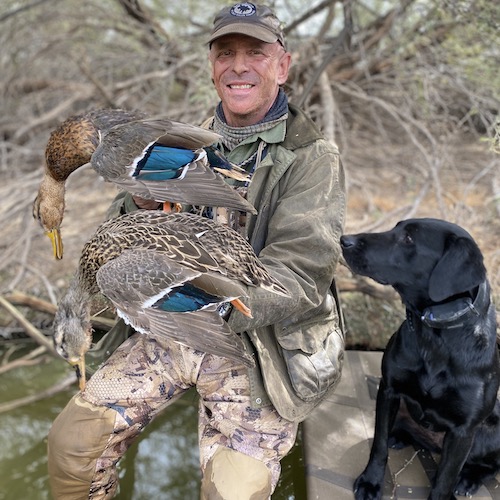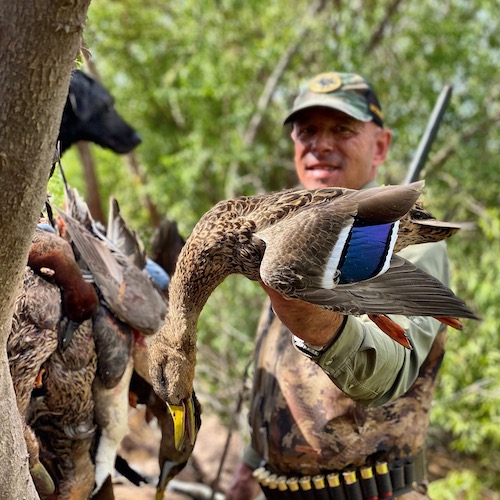Mexican Duck

Mexican Ducks (Anas diazia), aka Mexican Mallards, can be difficult for identification because this species, like Mottled Ducks, look very similar to Mallard hens with darker plumage. This is because they are a part of the North American “Mallard Complex” consisting of American Black Duck, Mallard, Mexican Duck, and Mottled Duck, which are all related. Previously considered a mallard subspecies, in 2020, the American Ornithological Society officially deemed Mexican Ducks a distinct North American species. as one of the least studied and well-known waterfowl in America, Mexican Duck drakes of this species display a pale head and rich ruddy-colored chest that differ from the rest of their brown plumage.
The only difference in plumage between Mexican mallard sexes is that the hen’s chests are the same color as the rest of their body. Since both sexes have the same dusky orange colored legs and general plumage, the easiest way to distinguish between sexes using the bill color and relative body size. Experienced hunters have little problem shooting drakes only for these reasons. The hen’s bill more closely matches the orange leg color than the drake’s pale-yellow bill. Both have an iridescent blue-green speculum and light linings that contrast with the darker underwings readily seen during flight. As compared to other species within this mallard complex, only the Mexican Duck and Mallard express double white wing bars bordering their speculum.
Available Hunts
-
Mexico Duck Hunting Obregon
Mexico duck hunt combo for real duck hunters. All-day hunts for broad variety of Central Flyway and Pacific Flyway duck species.
...read moreMexico duck hunting combo in Obregon is an action-packed “real duck hunters duck hunt” for ducks, doves, options for trophy bass fishing and quail.
- Trophy duck species for nearly all Central and Pacific flyway species to include cinnamon teal, Mexican mallard, more!
- Generous bag limits
- Elegant and Gambel’s quail, trophy largemouth bass fishing options
- Premium, 9-bedroom estancia and unequalled guest services
- Featured – Wildfowl, World of Beretta, MOJO TV, Outdoor Life, NRA Hunter, more
Rate: $4,880 (4-day hunt) -
Mexico Duck Hunting Sonora
Mexico Duck Hunt package is intended for private groups of 4-7 hunters.
...read moreMexico Duck Hunting Sonora Combo was developed at the request of many repeat clients who wanted to enjoy morning Mexican duck hunting, afternoon dove hunts, with their own exclusive groups.
- 4-night, 3-day packages, January-February
- For private groups of 4-6 hunters
- Morning duck hunts, afternoon dove hunts
- Premium, 4-bedroom estancia, all bedrooms with ensuite facilities
- Excellent waterfowl species selection
Rate: $4,080 (3-day hunts) -
Texas Waterfowl Hunt – Desert Paradise
Texas waterfowl hunt packages features relatively unpressured ducks, geese and sandhill cranes in an area so large it takes 3 lodges to cover and so ecologically diverse that most Central Flyway waterfowl species can be hunted!
...read more- Inclusive Texas waterfowl hunting packages for ducks, geese, sandhill cranes, doves, early blue-winged teal, spring turkeys, more.
- 3 lodges to cover vast, relatively undisturbed waterfowl hunting area and to offer flexibility for desired bucket-list species, amenity-level needs, or personal budget
- Central flyway puddle ducks to include prized mottled duck, Mexican duck, cinnamon teal, fulvous whistling duck, black-bellied whistling duck opportunities all right here in USA
- Sandhill crane hunting and white-fronted goose hunting are the Speck Ops Waterfowl house specialties
- Luxurious lodging with over-the-top and fun activities provide fun for bachelor or business hunting groups, entire families and non-hunters,
Rate: $2,000 to $2,900

The estimated breeding population for Mexican mallards is robust, and has fared well with agricultural developments through the Sonora desert. The Mexican Duck does not travel very far and can be found year-round central Mexico because of their preference for arid locations. From years experience, I associate them primarily with the Sonora Desert, but other populations can be found in New Mexico and Arizona at any time during the year. “Mexican Mallard” numbers are growing significantly in South Texas brush country, where their range is increasingly overlapping coastal mottled ducks. While few in numbers, Mexican Ducks have adapted to use man-made water sources used to irrigate regional crops. Natural habitats that they will use include lakes, reservoirs, and ephemeral and permanent wetlands. During breeding seasons the requirements are permanent water levels and dense vegetation. The few that do migrate for the wintering period will mostly stay along the border of Texas and Mexico. In Texas, Mexican Ducks, Mottled Ducks and American Black Ducks are collectively referred to as “dusky ducks,” with a 1-daily bag limit imposed.
Foraging and food sources are similar to mallards, primarily vegetative shoots and stems and invertebrates. During the months of November and December, when wheat crops are being irrigated, they will walk down planted furrows, gorging themselves on seed wheat, returning to freshwater ponds with their gullets full. Mexican ducks respond to decoys and soft, mallard-like calls similarly to mallards, and represent one of the most under-pressured mallard resources in North America.
Dr. Phil Lavretsky has conducted extensive genetic studies of species within the North American Mallard Complex, to include Mexican ducks. This fascinating topic was discussed on a Duck Season Somewhere podcast entitled Just a Mallard? Think Again.




















